Our vacation to the Benelux countries started with travel delays – a common theme with our recent trips. Our Air Canada flight was out of Ottawa, which we much prefer over the Montreal-originating flights (KLM, Air France, Swiss Air). However a series of severe thunderstorms, which had spawned an F0 tornado the previous day, caused 5-second power failure at the airport. This played havoc with the security systems and caused all the flights from Ottawa to be delayed. Our flight took off three hours late. This meant we missed our connection in Frankfurt, but Air Canada had already rebooked everyone on the next flight to Amsterdam. Once in Amsterdam, we were treated to a concert by the KLM Airline band before taking the hotel shuttle. Because our flight was so late, we had to take the Connexxion shuttle to our hotel – the Globus shuttle had already left. We had our welcome dinner at the hotel.
The first full day of our vacation started with a boat tour of the canals. It was lovely and picturesque. I could not hear the local guide’s descriptions, as I went to the open area at the back of the boat to get the best photos. After the canal tour, we went to the Rijksmuseum Amsterdam, where our local guide gave an overview of famous Dutch painters and paintings, such as “The Milkmaid” by Vermeer and culminating in “Night Watch” by Rembrandt.
Rosa and I took a short snack break at the nearby Cobra Café before re-joining our group for a visit to the Coster Diamond Exhibit next to the museum. We watched diamonds being polished. As with our previous tours, we were then taken to a (locked) room and shown diamonds that were available for purchase. The jeweller presented a number of diamonds of various sizes and colours, including one of which she claimed was worth €132,000. Later, we discovered one member of our group worked in the jewellery industry and she said that we might not have been shown real diamonds during the presentation as the presenter did not take the same security precautions that she herself was forced to take at her place of business. For example, she was never allowed to turn her back when the diamonds were within reach of anyone, even when the room was locked.
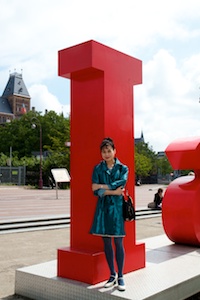
After the diamond exhibition, Rosa and I crossed the street to take some photos in Museumplein, a beautiful public lawn and an adjoining square. It was a wonderful sunny day.
As we walked the short distance back to the hotel, I stopped at a deli for a sandwich, and then I walked along the street taking pictures while Rosa shopped. Amsterdam is famous for its bicycles. It seemed like every resident had one. There are designated bike lanes on the sidewalks and streets. This means that you need to look both ways when leaving a building to make sure that you are not run over by a bike. There was a multi-level bike parking structure, called Fietsflat, near the Central Station; it must have held 4,000 bikes.
Later in the afternoon, we went on the optional excursion to the seaside village of Volendam. Along the way, we stopped at a clog and cheese maker. Both the clogs and cheese were made by hand. After that, we stopped at De Kathammer, one of the many windmills for which the Dutch are famous. De Kathammer was built around 1650, and was repaired after a fire in 1896.
There was some sort of festival in Volendam; it was very crowded. There were rock bands playing throughout the village, and the bars were full to bursting. We had dinner at De Koe (The Cow). I was hoping for a good fresh fish dinner, but it was just deep-fried. It was all you can eat, but I could only barely finish one serving. The apple pie was good though.
After returning to the hotel, Rosa and I went for an evening stroll in the nearby Vondelpark. It was such a lovely evening. There were scores of people out for a walk, having a picnic, or riding bikes. We stopped and took some fantastic portraits in front of a flower garden.
The next day started early with a visit to the massive FloraHolland flower auction in Aalsmeer. It is the fourth largest building in the world by floor space. The building is nearly 700-metres long! The auction starts at 6:30AM; we arrived at 8:30AM.
When we entered the massive building, it seemed we might have missed most of the auction action, as all we could see were rows of empty trolleys. We could see off far into the distance but could make out little activity from the entrance. There were two long skywalks the length of the building, 6-metres above the floor.

As we walked along the skywalks we saw more boxes of flowers on trolleys and increasing activity. Near the center of the building, the activity was frenetic. There were hundreds of people, some driving electric trolleys towing trains of carts. In the middle of the building were five huge enclosed auction rooms. There were a hundred buyers at computers in each of the active auction rooms. Rosa noticed that all the buyers were male for some reason. At the front of the room were two huge screens that were used for the auction. Data for each lot of flowers was shown on the screen, surrounded by what looked like a clock face. Lights around the edge of the clock moved quickly around the clock face counting down the price per stem. The buyers would press a button to buy; as the price counted down, the first bidder wins.
The auction handles €4 billion per year or €16 million per day, which is 48,000,000 flowers per day.
Next we drove to the Royal Delft factory for a tour. The factory building dates back to 1653. It was not as frenetic as the auction of course. I liked the exquisite garden in the middle of the factory building. After the tour, Rosa had a cappuccino and I had a citreontaart in the gift shop / café – it was delicious!
Around noon we were dropped off at the market square of Delft. It is a lovely, quaint town square. At the opposite ends are the Nieuwe Kerk (New Church, 14th century) and the Stadhuis (town hall 17th century). Nearby is the Oude Kerk (Old Church, 13th century) with its leaning bell tower. I had a bagel for lunch and then we both had gelato. Rosa did some more shopping around the town and I stalked the locals with my camera.
The tour continued to The Hague. We took photos in front of the working palace for Dutch Queen Beatrice. The next stop was the International Criminal Court. On our bus tour of The Hague, we also saw the prison where Ratko Mladić was being held during his trial for the International Criminal Tribunal for the former Yugoslavia.
Back in Amsterdam, we took the optional afternoon tour. First stop was the Anne Frank house. There is a quote, apocryphally attributed to Stalin, “The death of one person is a tragedy, the death of millions is a statistic.” Rosa and I have visited the sites of former concentration camps and the Yad Vashem in Jerusalem, but the story of one little girl brought home the horror of the Second World War. The tour of the secret annex where she and her family hid from the Nazis for two years was sombre.
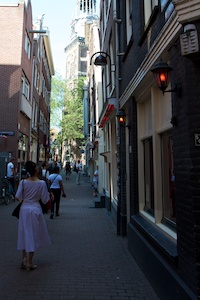
Next we had a walking tour of the infamous red-light district. The tour director offered no commentary during the walk through the narrow alleys. There were rows of entrances with red lights above the door. When the light is on, the prostitute is available. Some of the doors were open (and the red light on) and the girls were standing in the street-level doorway wearing bikinis and sometimes fishnet stockings. I did not expect that they would be standing in the doorway like that. I had assumed it would be discrete, like in a brothel with a main entrance and then the bedrooms in the back, down a hallway. But in the red-light district, the doors opened onto the street, and you could see the bed just behind the prostitute. Photographs are prohibited – we were warned that cameras could be thrown into the canal if we took any photos of the girls.
Nearby were the head shops and cafés where young people could chill out on big cushions while taking a hit from the bong on the table.
Also nearby was the gay centre of the city.
The walk ended at Dam Square and on to our dinner at Haesje Claes restaurant.
The following morning we left Amsterdam. Most of the day was spent driving to Luxembourg. The trip started sadly as we drove by a fatal traffic accident in the opposite lanes. A car, a military transport and a large cargo truck were involved. One of the soldiers was lying dead on the road under the cargo truck, and police were attending to the others. It must have happened shortly before we drove by; the fire trucks were just arriving as we passed. The parents on the tour told the children to close their eyes or look away. We later read that two people died and five were injured.
We reached Maastricht by noon. Maastricht is possibly the oldest town in the Netherlands. It has been continuously inhabited since Roman times. We stopped near the pedestrian shopping area. Rosa and I were both surprised when I spent more than she did – I bought a button shirt and a pair of Van Wallis shoes, both on sale. Rosa had gelato for lunch again, and I had a chocolate-filled Belgian Waffle.

The next stop was Bastogne, a key town during the Battle of the Bulge. The Battle of the Bulge was one of the last large-scale battles on the Western Front. Hitler wanted to halt the Allied advance by cutting off the supply lines from the port of Antwerp. The battle around Bastogne lasted about a month, during the bitterly cold winter of 1944. The Germans had 120,000 men, the Allies only 11,000. The battle, which was won when Patton’s Third Army broke the siege of Bastogne, was portrayed in the excellent Band of Brothers HBO miniseries.
We grabbed a quick bite to eat for lunch. Nearby, we visited the Mardasson Memorial. It is a 12-metres tall monument in the shape of the 5-pointed American star. When we arrived, there was an older man who was sitting at the edge on the top of the Monument, past the safety railing. We were scared that he might jump. When I was on the roof, I approached him and asked him if he was ok. He calmly said he was ok so I left him alone. He did not seem distressed. Should I have done more? Someone on the tour said that he also spoke Russian. When we were leaving, two police vans rushed past on their way to the monument.
We continued on to Luxembourg. Rosa did a little bit of shopping before we had a group dinner in the hotel.

On Wednesday a light drizzle started in the morning and the temperature fell to 20 degrees. We started with a bus tour of the city. The city of Luxembourg has a population of 120,000. Our first stop was the US Military cemetery. Over five thousand servicemen (and one servicewoman) are buried there. Many of the soldiers died during the Battle of the Bulge; others died in the liberation of Luxembourg. General Patton is also buried here with his troops. The average age of the U.S. servicemen in the cemetery was 28.
Nearby was a German military cemetery. There were 10,000 German dead buried there. During the final year of the war, the increasingly desperate German military used younger and younger recruits; the average age of the soldiers in the German cemetery was only 18.
As the drizzle had stopped we took a short walking tour of the area around the Notre-Dame Cathedral. We had a light lunch (Rosa a mangé un tomate avec crevettes, et j’ai mangé un rouleau fromage), and then Rosa did some more shopping.
In the afternoon, we took the optional tour to Trier, Germany.
The city of Trier dates back thousands of years. During the 3rd and 4th centuries it was the fourth largest city in the world as Roman Emperor Diocletian (late 3rd Century AD) made it the capital of one quarter of the Roman Empire. There were three sites that were especially interesting.
The first site was the Basilica of Constantine. It was built around 310AD. It is a UNESCO World Heritage site and has the longest extant hall from antiquity. The roof was quite an engineering achievement as it spanned 26 metres without using arches.

The Porta Nigra, or Black Gate, is a massive triumphal arch built between 186 and 200AD. It is made from limestone that has turned black from 1800 years of pollution. In the 11th century a monk, named Symeon of Trier, lived in the gate. After he was sanctified, the gate was converted into a church. Napoleon ordered the gate to be restored to it original Roman design. Next to the Porta Nigra was a house where Karl Marx once lived.
The third site was the Trierer Dom, or Cathedral of Saint Peter. It is the oldest cathedral in Germany and is also a World Heritage Site. It was completed in 1196, built to replace two previous structures that had been destroyed by the Franks and the Normans respectively. It contains a holy relic, the Seamless Robe of Jesus. Saint Helena, mother of Emperor Constantine, supposedly found the robe and it is claimed to be the robe worn by Jesus during the crucifixion. The relic is only displayed on special occasions. The treasury also houses a Holy Nail, again supposedly used for the crucifixion.
We also saw the ruins of the Roman amphitheater and Roman Baths (second largest after the Baths of Caracalla), old city walls and a bridge, the “Römerbrücke”, that was built on the original Roman foundations (200AD) and is still is use today.
One site I would have liked to visit is the Benedictine abbey St. Matthias were the thirteenth apostle St. Matthias is supposed to have been buried. St. Matthias replaced Judas Iscariot after he committed suicide for betraying (or being the only one who understood) Jesus.
After the walking tour, we had some free time. Rosa went shopping and I walked around taking photos and looking around. There are so many beautiful, interesting facades in the shopping area.
We had dinner at Berghotel Kockelsberg, a hotel overlooking the Moselle valley in which Trier is situated.
On Thursday we visited the battlefield of Waterloo on our way to Brussels.
We saw many battlefield monuments as we drove through the area around Waterloo. At the visitors’ center we watched a short but good video of the battle, although I felt it deemphasized how crucial battlefield communications led to Napoleon’s defeat. Mixed and confusing messages to Marshal Grouchy meant that some badly needed French troops never arrived. The video did cover the tactical brilliance of Wellington who had his troops deployed on the reverse slope of a ridge. When Napoleon started his artillery bombardment, the shells cleared the top of the hill but flew metres over the heads of the Wellington’s soldiers, injuring no one. The strategy also prevented Napoleon from having a true understanding of the number and position of Wellington’s troops.
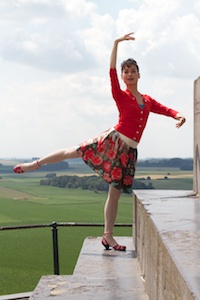
Next to the visitors centre is the Lions Mound. It is a 43-metre call conical hill, constructed from ground of the battlefield and built on the spot where William II of the Netherlands was struck by a musket ball. On the top of the mound is a 28 tonne iron statue of a lion. Rosa and I took some staged photos at the top of the Lions Mount. With the brilliant noon-hour sun, I wanted to use some fill flash. However when I opened the aperture to f/1.4 to get a nice bokeh, the flash blew out the exposure. I found later that I didn’t have the flash in high-speed sync mode, which would have corrected for the extremely short shutter speed.
After we arrived in Brussels, we had a bus tour by many of the interesting sites, such as the Cinquantenaire triumphal arch, the Royal Palace of Brussels, the Basilica of the Sacred Heart and the massively imposing Brussels Palais de Justice. The Palais de Justice (Palace of Justice) was the largest building constructed in the 19th century. It is bigger than St. Peter’s Basilica in Rome.
Once at our hotel, we had a short walking tour of the area. The absolute highlight was the Grand Place, or Grote Markt, which I feel is the most beautiful square in the world. All the guildhalls around the square are in a Baroque style with gold highlights. It was a breathtaking sight.
All the way were Belgian chocolate stores, and Belgian waffles with chocolate and pastries. It smelled so good. With our dinner reservations in three hours, Rosa and I had ice cream from Dandoy. It was the best ice cream I’ve ever had. Dandoy is next to one of the famous Brussels landmarks, Manneken Pis.
Manneken Pis, literally “Little Man Pee”, is a little statue that appears to be peeing. The area was always full of tourists. Each day, the statue was dressed in different clothing, such as a soccer team sweater, or a raincoat when it rains.
Next, we went shopping. Rosa bought me a dinner jacket and two pairs of shoes. I bought a tie and looked around for a place to buy some neutral density filters; I was still trying to figure out why I had problems with my camera in Waterloo.
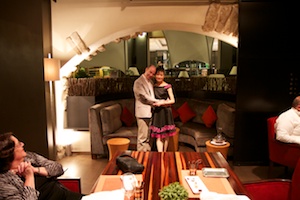
That night was very special. When we arrived at our hotel in the afternoon, Rosa made dinner reservations at the Sea Grill, a Michelin-starred restaurant. We had dinner with Phyllis and Chuck, who were in our tour group. It was very fancy. There were many small dishes (amuse-bouche) before the main course. A nearby table ordered the Lobster Press. This was absolutely fascinating. It was a large silver press, firmly bolted to a trolley. The press was hand-made in Paris, and costs €30,000! There are only four in the world. After removing the meat, the lobster is put in the press and two people turn the press to create lobster jus, which is then added to a béarnaise sauce that is apparently very rich and delicious.
For our penultimate day, we visited Brugge (Bruges). Rosa and I thoroughly enjoyed the movie “In Bruges” and we were looking forward to visiting the town.
We had a walking tour of the town, dodging horse carriages along the way. Halfway through the morning we had a canal boat tour. Bruges is the third place we’ve been that is called the Venice of the north, (others included St. Petersburg and Amsterdam). I guess pretty much any place that has even a single canal calls itself that.
We visited the Church of Our Lady, which has the statue Madonna and Child by Michelangelo, one of the few pieces from the artist that left Italy during his lifetime. The tower of the church is the second tallest brickwork tower in the word.
To enter the town square, we walked through the famous Belfry, a medieval bell tower. It was built in 1280 and has 48 bells. It was originally taller, but a lightening strike caused a fire that destroyed the wooden spire on top.
We saw a lace-making demonstration in a small shop just a block from the main square. It takes years of training to be able to make the highest quality lace. There are fewer and fewer lace makers in Bruges.
I had wanted to see the painting The Last Judgment by Hieronymus Bosch at the Groeningemuseum, but I did not have enough time. I needed to eat first!
Rosa and I ate lunch at a tearoom with a great view of the passing crowds. I ordered a very delicious Belgian waffle with chocolate, vanilla ice cream and sprinkled with icing sugar. I could have spent all day there under the awning watch the crowds surge past, but we had to return to the tour bus.

Upon returning to Brussels we went shopping again.
For our final day, we took the final optional tour, this time to Antwerp. Antwerp is a very important port on the English Channel. In the Second World War, it was the only city that was hit by both the German V-1 flying bomb (2,448) and V-2 rocket (1,610).
The first stop in the morning was the Plantin-Moretus Museum, home of a 16th century printing company. The museum houses the two oldest printing presses in the world. It also has a 36-line bible. It is possible that Gutenberg printed this bible but more likely it was printed in Bamberg, Germany around 1458-60.
There were two reasons why I wanted visit Antwerp. The first was the possibility of seeing a Gutenberg bible – one of the earliest printed books – and the other was to see the diamond district. I was a little disappointed to find out later that the bible on display was not a confirmed Gutenberg bible, and we were not taking to see the diamond district. The diamond district handles 80% of the world’s rough diamonds.
Next was the Onze-Lieve-Vrouwekathedraal (Cathedral of our Lady). The construction of this Gothic church was started in 1352 and was ready for use 170 years later. The construction of the second tower was postponed indefinitely after a fire gutted most of the church. Three important paintings from Peter Paul Rubens, who lived in Antwerp, are displayed in the church.
We had about 2 hours to explore the area. Nearby was the Grote Markt (“Grand Market”), which was delineated by the Stadhuis (“City Hall”) and the Guildhouses. For lunch, I had a Belgian waffle Rosa had a sundae – we couldn’t find a gelato place. Rosa did more shopping and I walked around taking photos of the crowds, the buildings and the bikes.
Returning to Brussels, we stopped for photos at the Atomium, which is a 102-metre call monument built for Expo ’58. It is in the shape of an iron crystal, magnified 165 billion times.
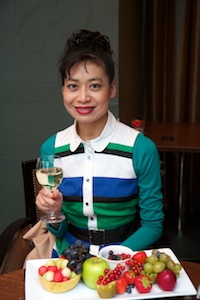
Our farewell dinner was very nice. Rosa asked for fruit and was presented with the most amazingly prepared plate of fruit. It was like a Renaissance painting.
The next day, we left for the airport very early. We had dinner plans on another continent. It was my birthday and we were meeting an old friend and his wife for dinner.
We landed in Ottawa in the afternoon and took a taxi home. We both showered; Rosa took a nap and I started downloading the photos into Aperture.
We met up with Dana and Kathy at Sweetgrass Aboriginal Bistro. I had buffalo.
Photo Gallery: http://gallery.myredbmw.net/v/Travel/Benelux2011/.

One Reply to “Benelux, Jun 2011”